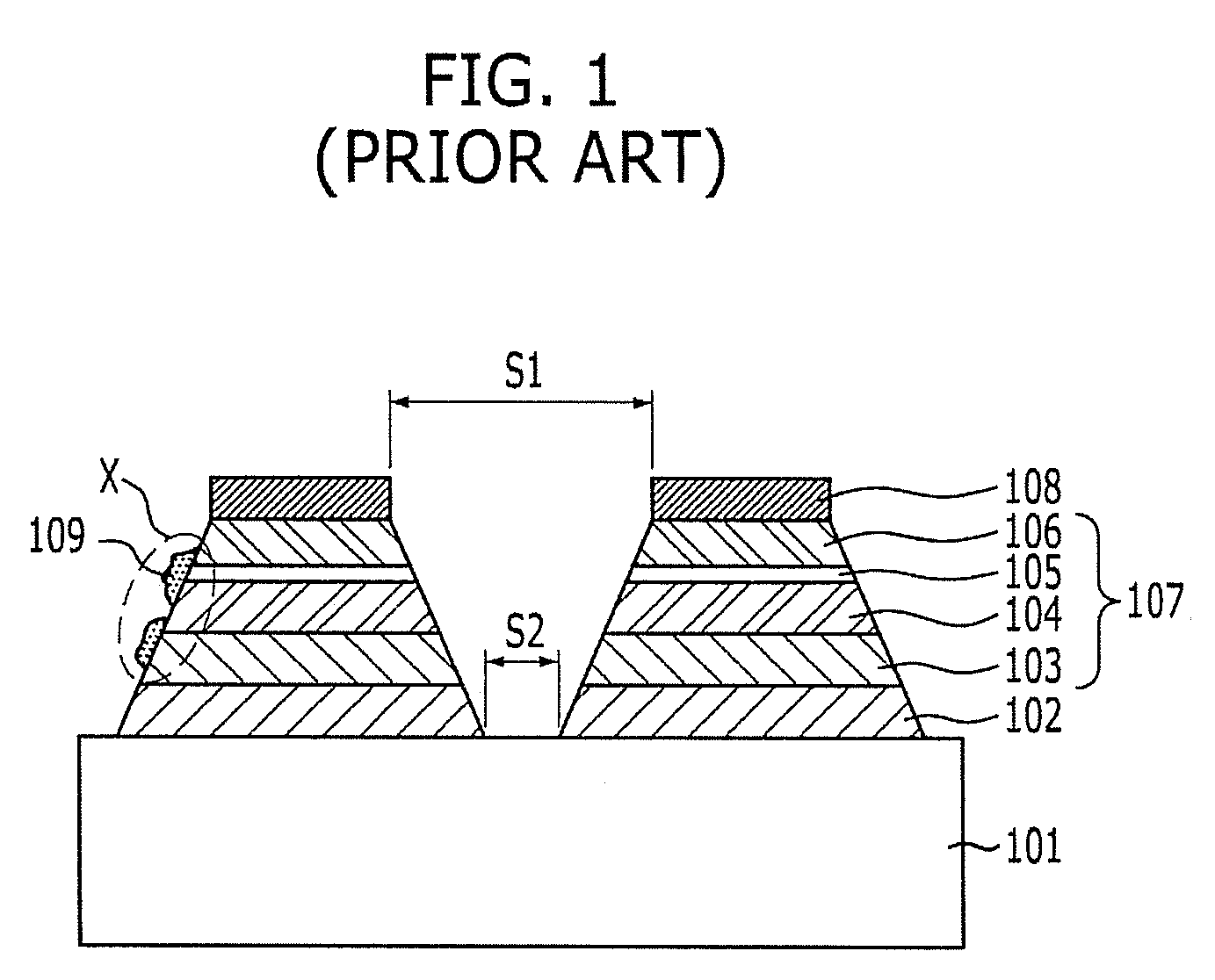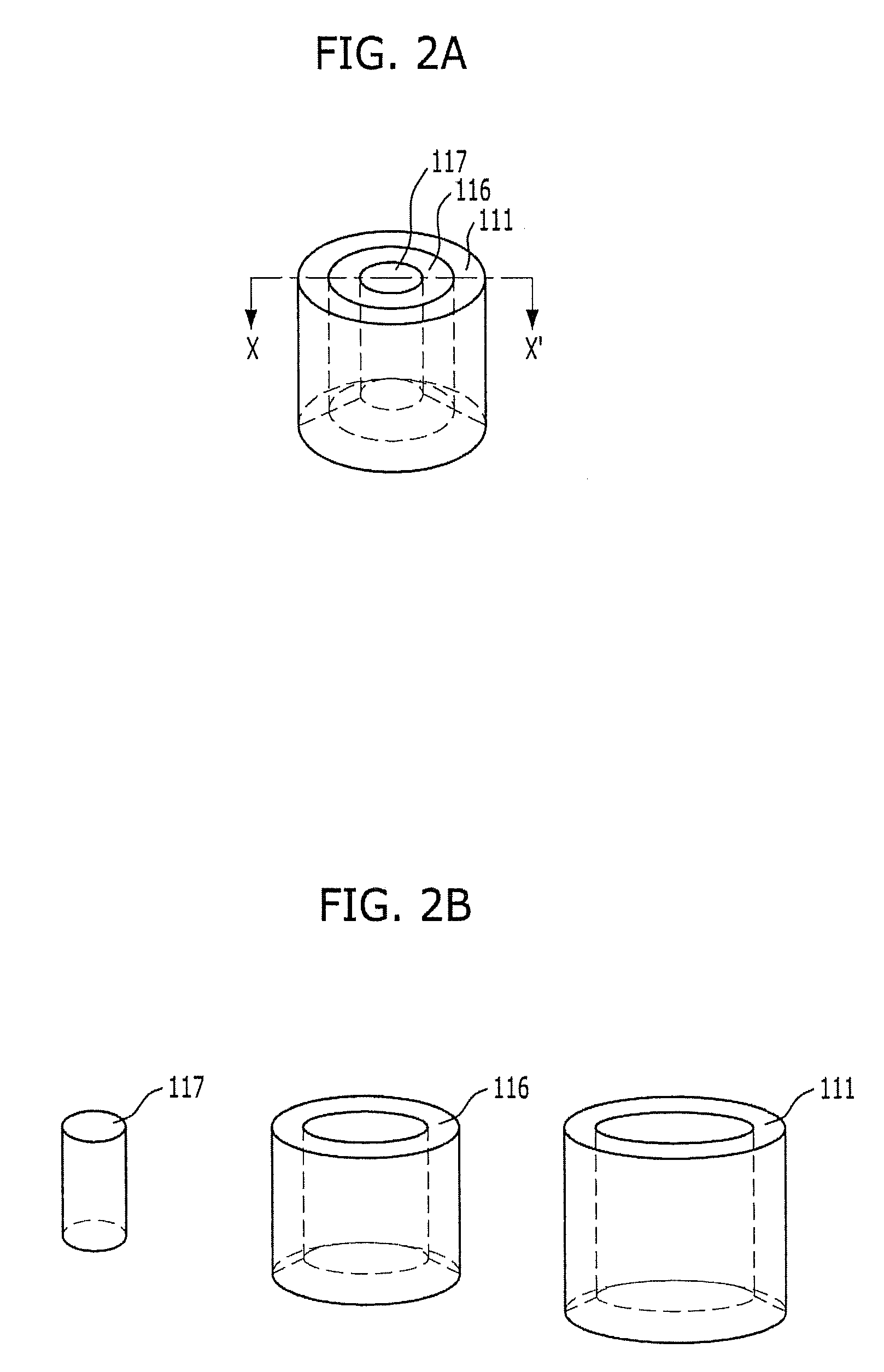Magnetic tunnel junction device, memory cell having the same, and method for fabricating the same
a tunnel junction device and memory cell technology, applied in the direction of magnetic-field-controlled resistors, semiconductor devices, electrical devices, etc., can solve the problems of deterioration of mtj devices, and inability of mtj devices to operate normally
- Summary
- Abstract
- Description
- Claims
- Application Information
AI Technical Summary
Benefits of technology
Problems solved by technology
Method used
Image
Examples
first embodiment
[0032]FIGS. 2A to 2D illustrate an MTJ device in accordance with the present invention. FIG. 2A is a perspective view of a unit of the MTJ device. FIG. 2B is a perspective view illustrating each separated component of an MTJ device. FIG. 2C is a cross-sectional view taken along a line X-X′. FIG. 2D is a cross-sectional view illustrating an MTJ device having a concave structure. Referring to FIGS. 2A to 2D, the MTJ device of the present invention has a pillar-type concave structure. Specifically, the MTJ device includes a pillar-type second electrode 117, an MTJ layer 116 surrounding the side and the bottom of the second electrode 117, and a first electrode 111 surrounding the side and the bottom of the second MTJ layer 116. Herein, the second electrode 117 may have a circular cylinder shape, a tri-cylinder shape, or a polygonal cylinder shape. Additionally, the first electrode 111 and the MTJ layer 116 may have a cylindrical shape.
[0033]Additionally, the MTJ device of the present in...
second embodiment
[0058]Hereafter, a memory cell including the pillar-type MTJ device of the present invention will be described with reference to the accompanying drawings. In general, an MR ratio of the MTJ device is determined by a magnetization direction of a free layer. Accordingly, based on a driving principle (for example, a magnetic field or STT) that changes a magnetization direction of the free layer, a structure of a memory cell including the MTJ device may be different. In the present invention that will be mentioned later, a memory cell using STT as a driving principle for changing a magnetization direction of a free layer is exemplified. In this disclosure, the STT can be described with reaction of giant magnetoresistive (GMR). According to Newton's third law (that is, a law of action and reaction), action is inevitably followed by corresponding reaction having the same magnitude and a reverse direction to the action. Herein, the GMR is a phenomenon that occurs because a current amount ...
third embodiment
[0075]FIG. 6A is a cross-sectional view illustrating a memory cell with an MTJ device in accordance with the present invention. FIG. 6B is a perspective view illustrating a unit cell of the memory cell of FIG. 6A. Referring to FIGS. 6A and 6B, a device isolation layer 202 is disposed on a predetermined region of a substrate 201 to define an active region 203. A plurality of gate electrodes 204 (that is, a word line) crossing over the active region 203 and the device isolation layer 202 at the same time are disposed on the substrate 201 including the device isolation layer 202. Herein, when a direction of the active region 203 is designated as a row direction which is the x-axis direction, a gate electrode 204 is disposed in a column direction which is the y-axis direction. A common source region 205S is disposed in the substrate 201 of the active region 203 between the gate electrodes 204, and a drain region 205D is disposed in the substrate 201 of the active region 203 at both side...
PUM
 Login to View More
Login to View More Abstract
Description
Claims
Application Information
 Login to View More
Login to View More - R&D
- Intellectual Property
- Life Sciences
- Materials
- Tech Scout
- Unparalleled Data Quality
- Higher Quality Content
- 60% Fewer Hallucinations
Browse by: Latest US Patents, China's latest patents, Technical Efficacy Thesaurus, Application Domain, Technology Topic, Popular Technical Reports.
© 2025 PatSnap. All rights reserved.Legal|Privacy policy|Modern Slavery Act Transparency Statement|Sitemap|About US| Contact US: help@patsnap.com



